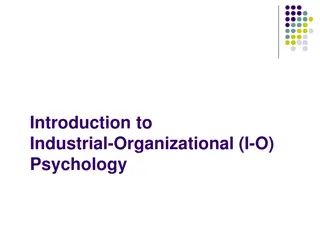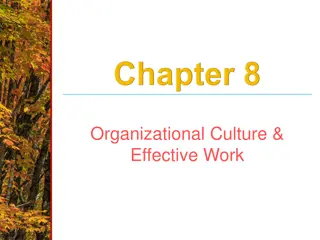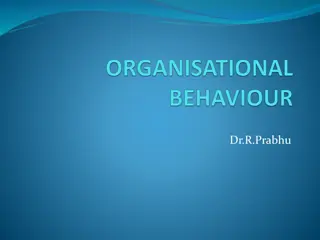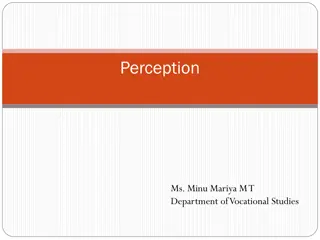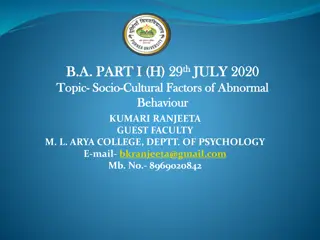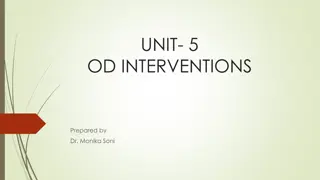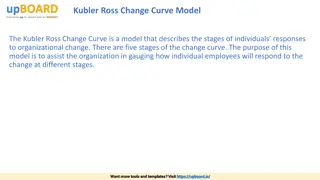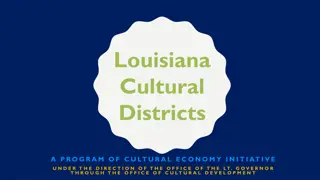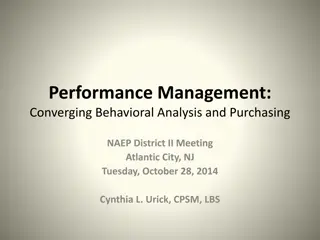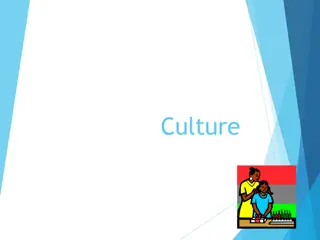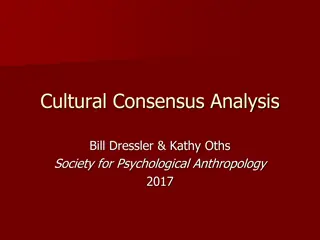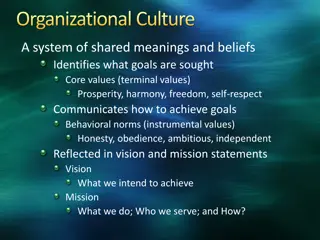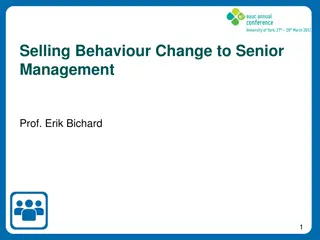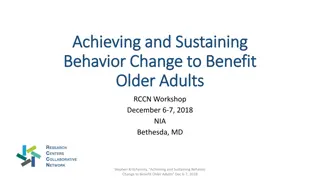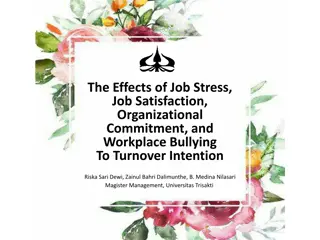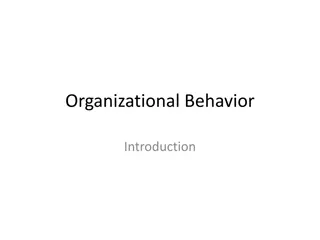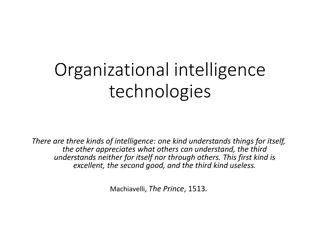Understanding Organizational Behavior and Cultural Change
Organizational behavior and business culture play crucial roles in shaping the success and effectiveness of an organization. This content delves into the significance of people as the driving force behind cultural change and highlights the importance of creating a positive work environment for optimal productivity. It also explores the interplay between organizational behavior and employees' interactions within groups, emphasizing the need for a scientific approach in managing workers. Ultimately, the focus is on fostering a conducive business culture that attracts and retains talented individuals while promoting overall well-being.
- Organizational Behavior
- Cultural Change
- Business Culture
- Positive Work Environment
- Employee Engagement
Download Presentation

Please find below an Image/Link to download the presentation.
The content on the website is provided AS IS for your information and personal use only. It may not be sold, licensed, or shared on other websites without obtaining consent from the author. Download presentation by click this link. If you encounter any issues during the download, it is possible that the publisher has removed the file from their server.
E N D
Presentation Transcript
People: the platform of People: the platform of cultural change cultural change By: Kimberlee Hancox, MBA
Every organization Every organization Contains a culture that defines who they are and what is important Positive Culture=thriving organization Negative Culture=poor results personally and professionally
People: the platform of cultural change People: the platform of cultural change New understanding of organizational behavior and culture Identification of internal gaps People need to be the primary focus for cultural change Resources to assist you in taking the first step to effective positive change
What is Organizational Behavior? What is Organizational Behavior? Organizational behavior (OB) is the study of the way people interact within groups. Normally this study is applied in an attempt to create more efficient business organizations. The central idea of the study of organizational behavior is that a scientific approach can be applied to the management of workers.
What is Business Culture? What is Business Culture? The corporate or business culture identifies the way in which your group connects with each other and with those external to the business. It is the tone that guides teams, inspires and motivates staff. Helps to attract and retain talented and positive people
Happy doctors, happy life? Happy doctors, happy life ? Nursing school lesson Keep doctors happy and all will be well .
What I used to think.. What I used to think ..
What I know now. What I know now . People must be the most important part of the pyramid
Case Study Case Study this just got real this just got real New administrator 18 employees 3 physician owners
Phase 1: Employee Satisfaction Survey Phase 1: Employee Satisfaction Survey Yes you really want to know how your employees are feeling
The survey questions The survey questions 1. My job performance is valued 2. I am generally happy and satisfied 3. I feel that I have been adequately trained for my job 4. The staff function as a cohesive team 5. I am able to voice my concerns without fear of retribution from peers
The results The results 37 % employee satisfaction rate Employees didn t feel valued They were unhappy Some required more education, but were scared to ask for help Teams didn t exist; only department silos Some staff felt bullied
Phase 2: People are the foundation for Phase 2: People are the foundation for change change Phase 1: Rounding on Employees Primary focus: build relationships and trust What is going well today? Do you have the tools and resources to do your job? If not, how can I help? Identify one employee that did something exceptional this week
Through rounding, we learn Through rounding, we learn Who the employees are and what they value What challenges they face daily; personally and professionally What level of organizational engagement they have
Simon Stineck: there are only two ways to influence human behavior: You can manipulate it or you can inspire it. Great leaders choose to inspire~
Phase 3: T Phase 3: T- -E E- -A A- -M Assessment M Assessment We need to recognize personality and communication styles to invoke positive change Employees were apprehensive at first, but all could agree that a culture shift needed to occur
Complete by working across the page, numbering the words in each row. Give a 4 to the word that most describes you, 3 to the next, then 2 , and 1 to the least. ____Feelings ____Details ____Possibilities ____Facts ____Security ____Order ____Inspiration ____Control ____Patient ____Accurate ____Talkative ____Bold ____Cooperative ____Analytical ____Enthusiastic ____Competitive ____Loyal ____Reserved ____Optimistic ____Daring ____Agreement ____Quality ____Ideas ____Results ____Calm ____Logical ____Persuasive ____Driven (T)____Total (E)___Total (A)____Total (M)____Total Add up each column and put the totals into each T-E-A-M.
The Ts(steadiness) The T s (steadiness) Priorities: consistency, cooperation, stability, established work patterns, team work Motivated by: stable environment, tradition, opportunities to support others Dislikes: CHANGE, risk, loss of stability, offending others Limitations: stubborn, avoids change Value to the organization: stable, predictable, problem solver, accomplishes goal with the team
The Es(conscientious) The E s (conscientious) Priorities: thoroughness, logic, facts and data, accuracy, analysis Motivated by: proper way of doing things, opportunities to use knowledge, quality Dislikes: inaccuracy, criticism, being wrong, working in a group Limitations: perfectionist, overanalyzes, defensive, analysis paralysis. Change? WHY!!??!!
The As(influence) The A s (influence) Priorities: creating a motivating environment, generating enthusiasm, developing an environment of trust Motivated by: participating in a group, freedom from control and details, friendly relationships Dislikes: static environment, disapproval, being ignored Limitations: inattentive to details, time management, impulsive Value to the organization: Cheerleader , initiates ideas, promotes projects and people.
The Ms The M s .(Dominant) .(Dominant) Priorities: solving problems, taking action, accepting challenges, quick decisions Motivated by: opportunities for advancement, responsibility, challenging and difficult assignments Dislikes: failure, loss of power and authority, vulnerability Limitations: not team oriented, unilateral decision making, impatient, move quick Value to the organization: seeks new and innovation, get er done mentality
If one letter is missing.. If one letter is missing .. We don t have a T-E-A-M Group projects are best if you have a balance of the four personality styles
Things to keep in mind. Things to keep in mind . The change of pace is much faster with the M s, but the T s not liking change will dig their heels in and be defensive. M s will need to slow down and not say do it now because I said so ; but instead listen and give data to support WHY the change is occurring. E s love details and data, but A s prefer to be the enthusiastic cheerleaders and don t require data to make the change.
How to lead the T How to lead the T- -E E- -A A- -M M Approach a T slowly and don t demand. Provide reassurance of stability and what won t change. Approach an E with logic and lots of data; demonstrate how change will improve quality. Approach an A enthusiastically and get them excited about the possibility of the future. Approach an M quickly and to the point; but allow them to be part of the change decision if appropriate.
Phase 4 Phase 4 The weekly newsletter The weekly newsletter What is the leader of the organization doing? Department updates Shout Outs very powerful!
So did any of this help? So did any of this help?
And the results.. And the results .. Silo d departments started communicating in new ways The T s, E s, A s, and M s began to appreciate each other Shout-Out s went from 2 or 3 per week; to 15-16. (including doctors!) People from different departments began doing things for each other out of choice, rather than force. A strange new sound was heard through the office laughter.
And the survey says And the survey says Our 6 month follow up survey demonstrated a 97% employee satisfaction rate. It has been 95% or greater consistently over the last 3 years. Last voluntary termination was September 2014.
Positive culture change equation Positive culture change equation L+V+I=Positive Culture Change L=Learn about them V=Value them I= Invest in them People are the foundation for cultural change . Leaders can inspire the change, but cannot do it alone
Contact information Contact information Kim Hancox Email: Kim@entalaska.com Phone: 907-334-1454



